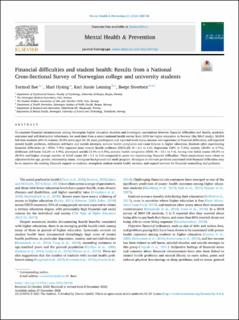Financial Difficulties and Student Health: Results from a National Cross-Sectional Survey of Norwegian College and University students
Journal article, Peer reviewed
Published version

Åpne
Permanent lenke
https://hdl.handle.net/11250/2762709Utgivelsesdato
2021Metadata
Vis full innførselSamlinger
- Department of Psychosocial Science [865]
- Registrations from Cristin [10412]
Sammendrag
To examine financial circumstances among Norwegian higher education students and investigate associations between financial difficulties and health, academic outcomes and self-destructive behaviours, we used data from a recent national health survey from 2018 for higher education in Norway (the SHoT study). 50,054 full-time students (69.1% women; 30.9% men) aged 18–35 years participated and reported work status, income and experience of financial difficulties, self-reported mental health problems, deliberate self-harm and suicide attempts, somatic health complaints and exam failures in higher education. Students often experiencing financial difficulties (n = 3933, 7.9%) reported more mental health problems (HSCL-25; M = 2.1 vs 1.6), depression (24% vs 7.2%), anxiety (20.8% vs 6.7%), deliberate self-harm (12.2% vs 4.9%), attempted suicide (3.1% vs 0.5%), somatic health complaints (SSS8; M = 13.1 vs 7.4), having ever failed exams (45.5% vs 28.4%) and higher average number of failed exams (M = 1.1 vs 0.6) compared to peers not experiencing financial difficulties. These associations were robust to adjustments for age, gender, relationship status, immigrant background and study program. Strategies to alleviate problems associated with financial difficulties may be to improve the existing financial support to students, strengthen student mental health services, and expand services for financial counselling and guidance.
